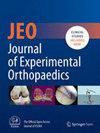Cross-sectional area on magnetic resonance images of the semitendinosus tendon is strongly related to the collagen fibril diameter
Abstract
Purpose
Using a thin semitendinosus tendon as an autograft is a risk factor for poor clinical outcomes after anterior cruciate ligament reconstruction. Preoperative evaluation of the cross-sectional area of the semitendinosus tendon using magnetic resonance imaging is useful. However, studies comparing the cross-sectional area of the semitendinosus tendon on magnetic resonance imaging and the collagen fibril diameter of the semitendinosus tendon are lacking. We aimed to investigate the relationship between collagen fibril diameter and cross-sectional area of the semitendinosus tendon using magnetic resonance imaging.
Methods
We included 14 patients (24.5 ± 12.3 years) who underwent anterior cruciate or medial patellofemoral ligament reconstruction using the semitendinosus tendon. Samples not used to prepare autografts were used to evaluate the collagen fibril diameter. Transmission electron microscopy was used to measure several hundred short fibril diameters per sample. Magnetic resonance imaging (T2-weighted imaging) was used to assess the cross-sectional area of the semitendinosus tendon, measured 8 cm proximal to the tibial attachment. Spearman's rank correlation coefficients were determined for collagen fibril diameter and cross-sectional area of the semitendinosus tendon on magnetic resonance imaging, and the relationship between both parameters was evaluated.
Results
The collagen fibril diameter of the semitendinosus tendon was calculated from 10,279 fibrils. The correlation coefficient between the collagen fibril diameter and the cross-sectional area of the semitendinosus tendon was 0.821 (p < 0.001).
Conclusions
A strong positive correlation was observed between the collagen fibril diameter and cross-sectional area of the semitendinosus tendon. A small cross-sectional area on the magnetic resonance image of the semitendinosus tendon indicated a thin collagen fibril diameter, which may affect the mechanical strength of the autograft for anterior cruciate ligament reconstruction. The collagen fibril diameter can be predicted preoperatively by measuring the cross-sectional area of the semitendinosus tendon using magnetic resonance imaging.
Level of Evidence
Level IV.


 求助内容:
求助内容: 应助结果提醒方式:
应助结果提醒方式:


